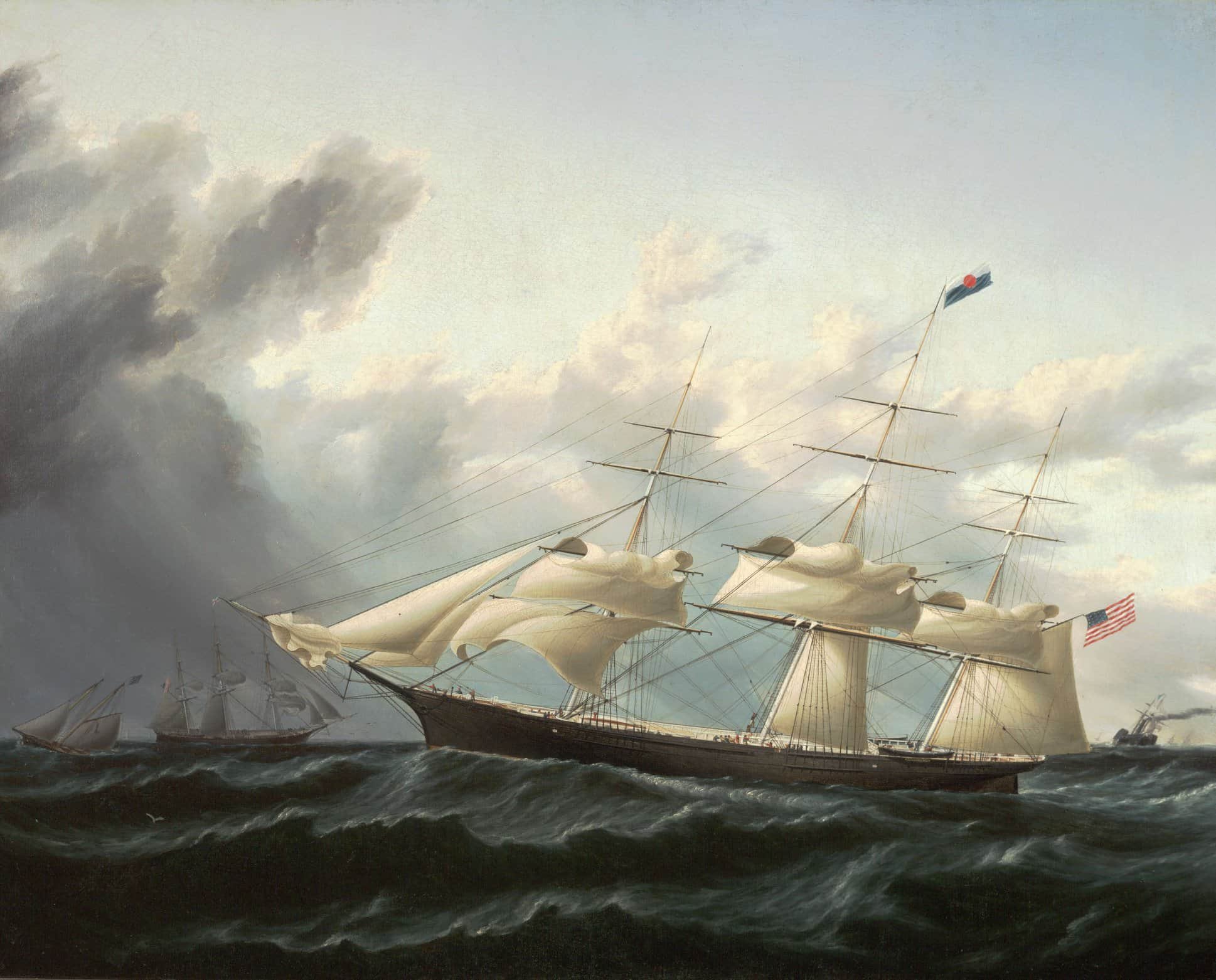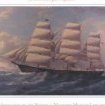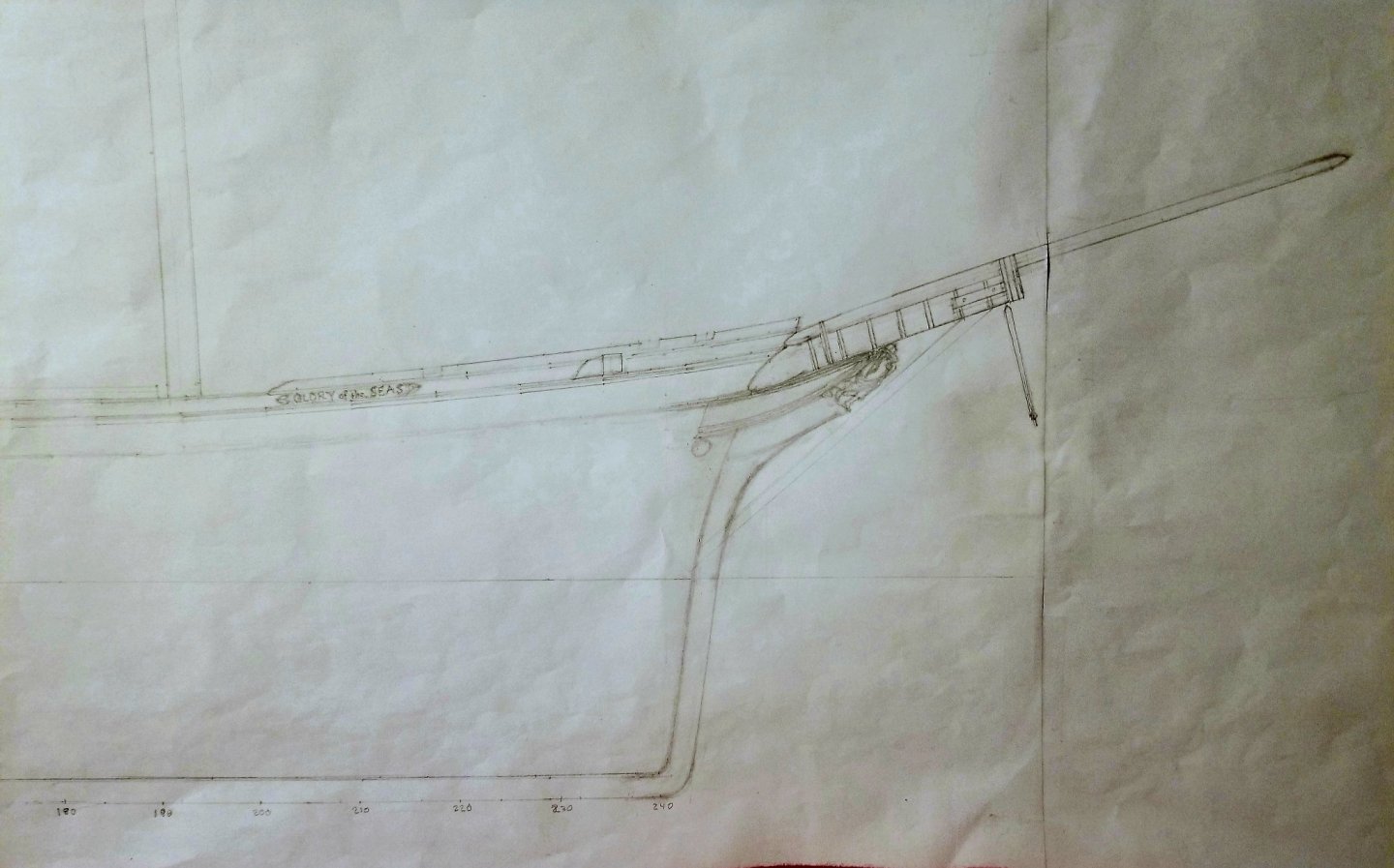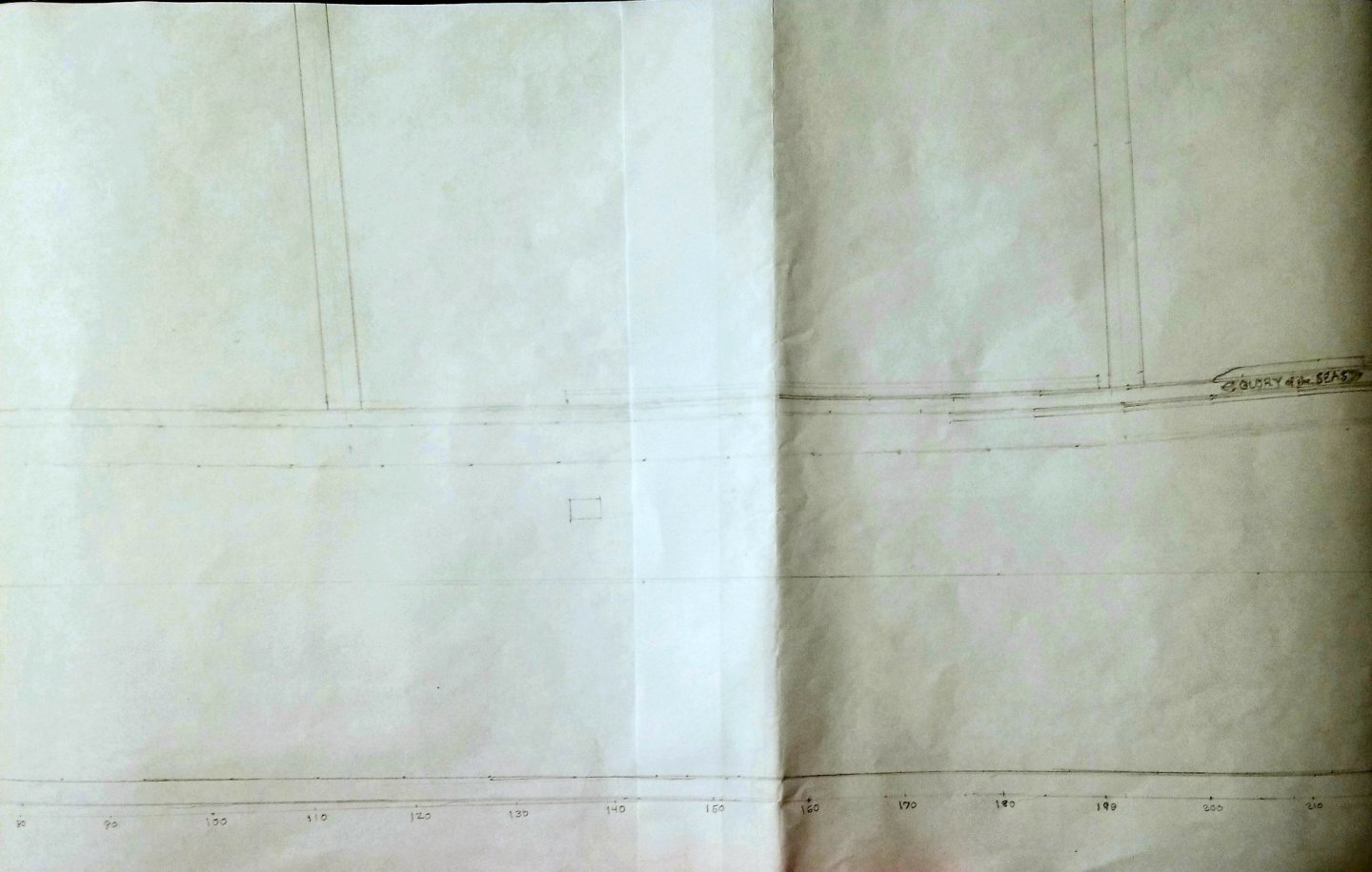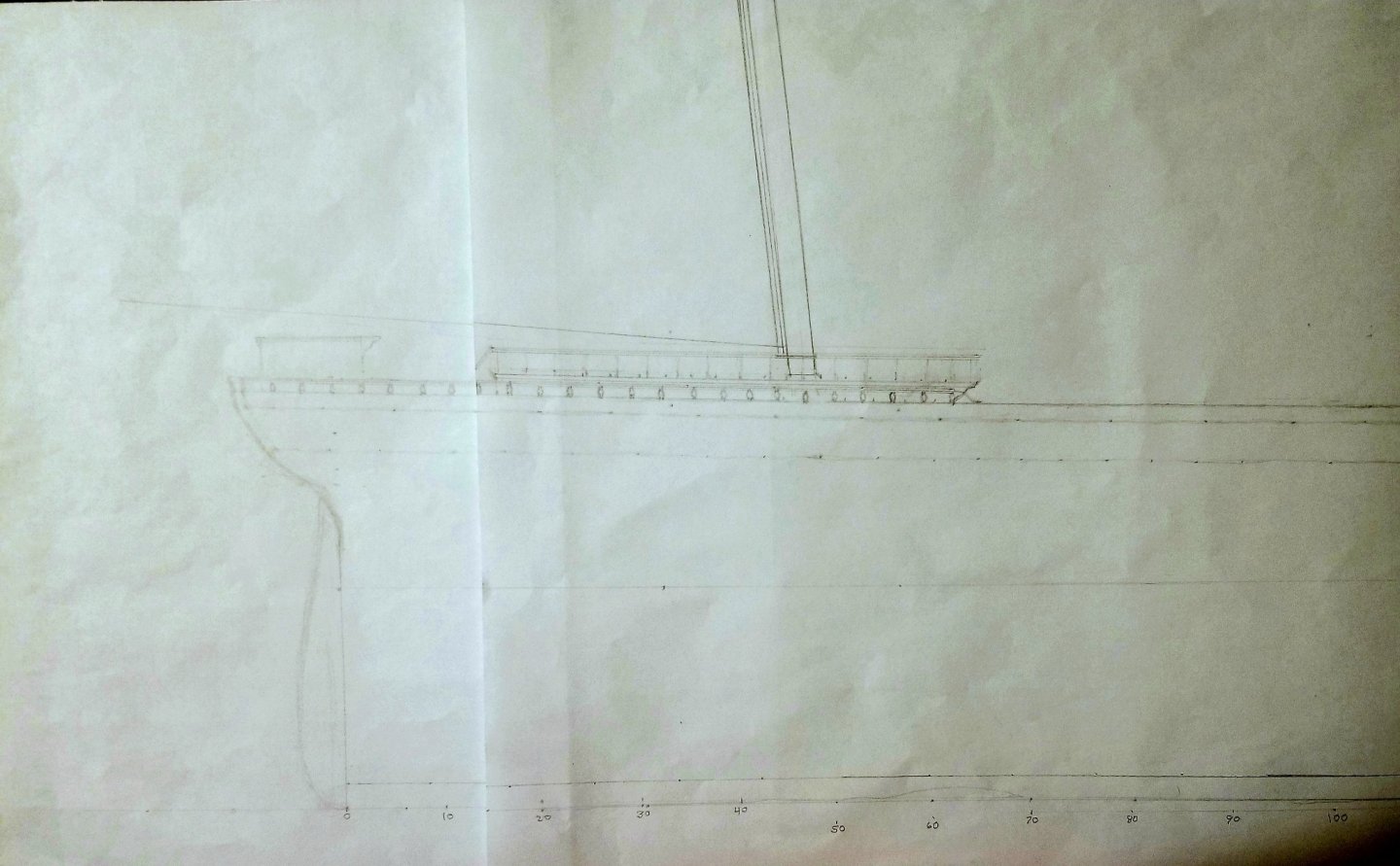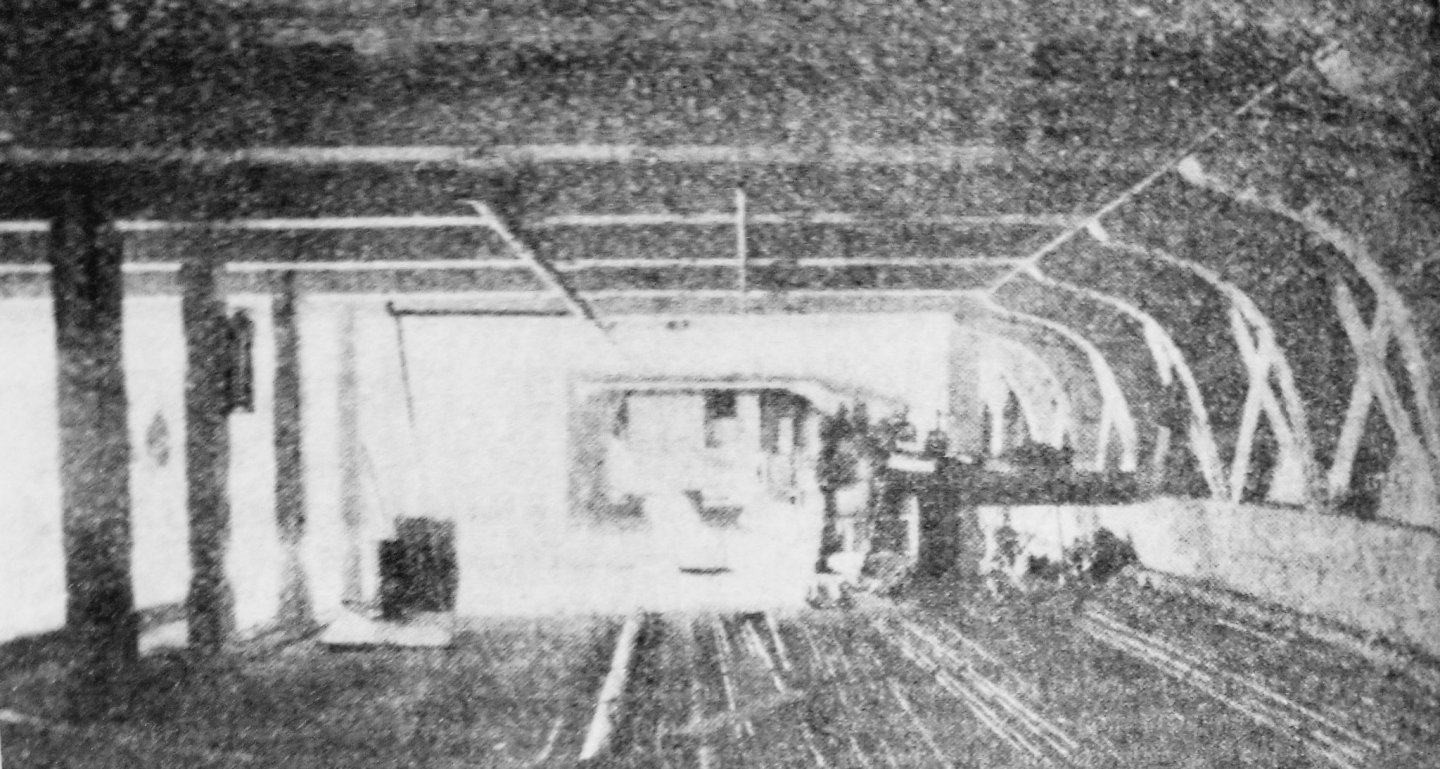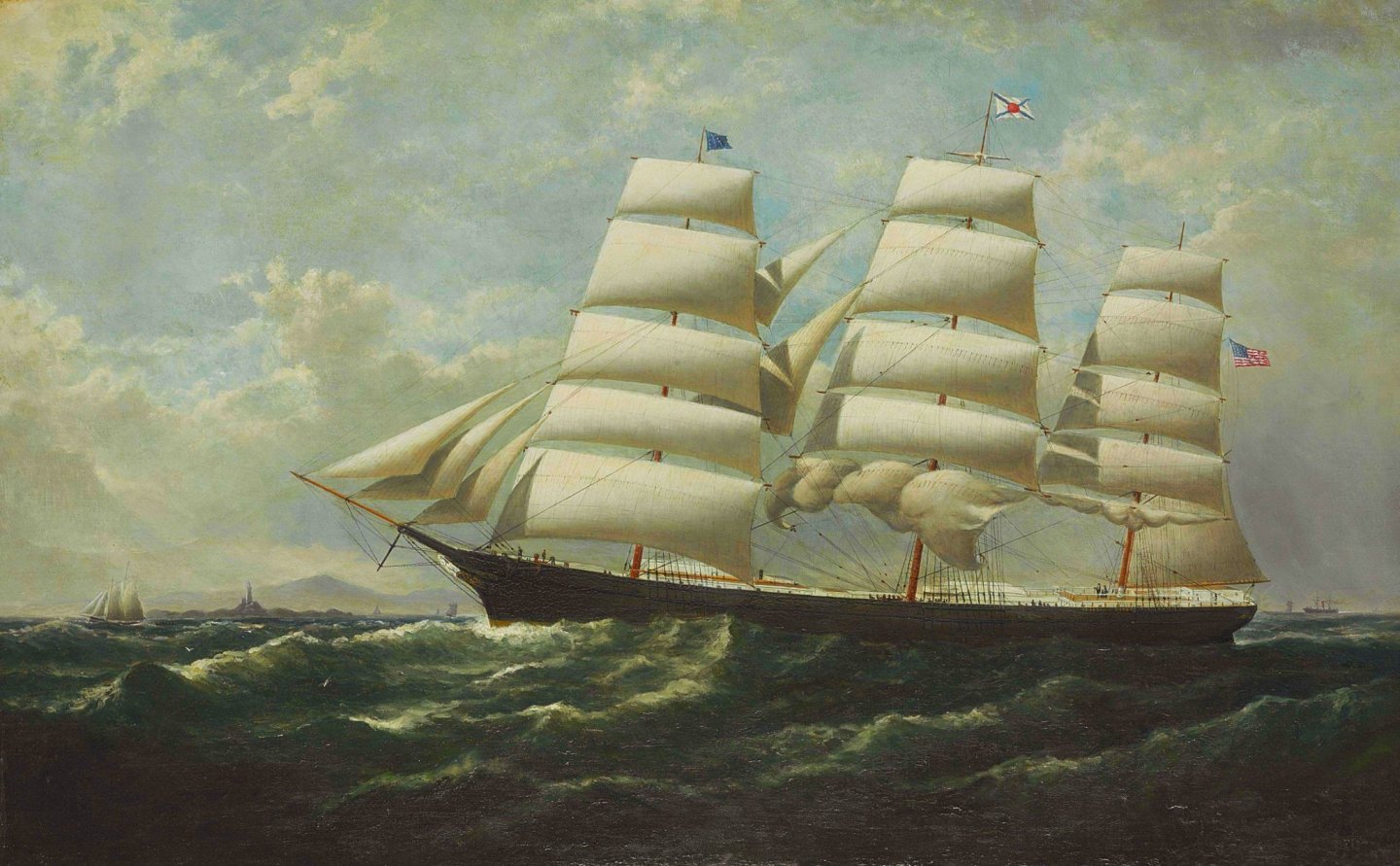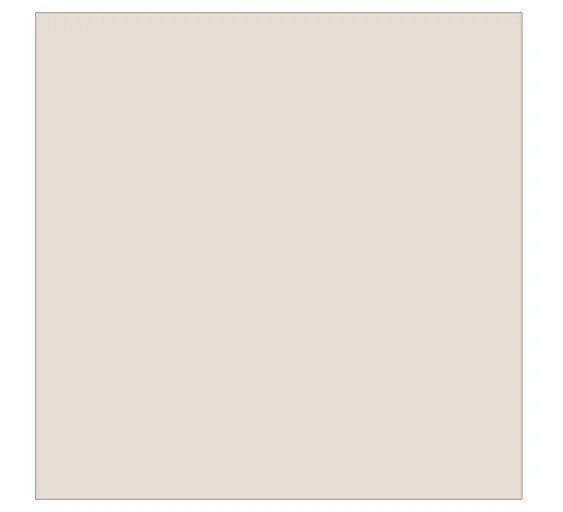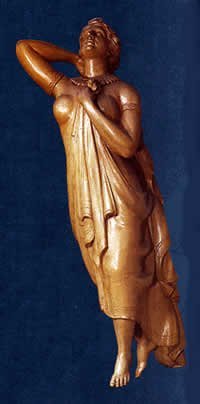-
Posts
2,152 -
Joined
-
Last visited
Content Type
Profiles
Forums
Gallery
Events
Everything posted by ClipperFan
-
Rob, welcome back! I hope you enjoyed your trip. The coppering process is so beautiful, even at this short beginning.
- 3,560 replies
-
- clipper
- hull model
-
(and 2 more)
Tagged with:
-
Rob & Vladimir I'm finally feeling well enough to go back to completing my vision of how "GLORY of the SEAS" truly looked. This sketch is precisely to 1:72nd scale err, oops per MrBlueJacket this is actually 1:96th scale (1" = 8' or 1/8ths"=1'). 1:72nd scale is 1/6ths"=1'. I don't have large enough paper to do one continuous drawing, so I've taped 3 ledger sized pages and added a section to include the entire Bowsprit & Jibboom. When you lay out the Keel to exactly 240' & Main Deck between perpendiculars of 250' it results in this Bow profile. With a 10' Stern, the distance from Taffrail to Knightheads of 265' matches precisely the profile as seen in the 1911 Seattle close up. FYI Glory's Grecian Goddess 'Athene' is exactly 7 1/2' from head to toe. This is still very much a work in progress but I wanted to share my progress with you and hear what your responses are. My eventual goal is to share this radically different interpretation of Glory's lines with Michael Mjelde to give him what I feel is a more accurate ship's plans than Ron Haug's still disappointing version.
- 3,560 replies
-
- clipper
- hull model
-
(and 2 more)
Tagged with:
-
Vladimir, I don't know if you recall seeing this before from the article I shared a few months ago. It's Michael Mjelde's "GLORY of the SEAS" - Medium Clipper Ship' article in Jan/Feb 1992 Vol III, No 1 SEAWAYS Ships in Scale publication. This actual internal image is of Glory's deck (my estimation is it's most likely deck 2 just below the main upper deck). A correction by the way. Main hatchway is 12' x 10' and the lower one is 14' x 12'. There are sufficient details about 16" sq waterways, 16" beams, stanchions, etc to do a very credible job, should you wish. Otherwise I won't bother you with any more minutiae.
-
Vladimir, you're welcome for the calculation. I figure after driving you nuts with all my other insistence on accuracy, you might just appreciate a helping hand, when I can. Figuring you're leaving the docks open leaves an opportunity to create an insert of sorts to give an impression of Glory's internal structure. For instance, each verticle rib is described as being exactly 28" center to center to the other. In the lower section they were 11" × 14" tapering to 10" × 12" towards the upper levels. More interestingly, each pair of ribs were cross trussed in between, corner to corner. The deck with these loading docks is described as having a hatch way 11' × 14' slightly larger than the main hatch way above which I believe was 10' × 12'. Of course, Hanging Knees would also need to be included as well as stanchions and upper deck beams. It wouldn't have to be too big. An insert could be built with hidden mirrors on both ends to create a greater sense of depth. Glory's criss-cross wooden beams were a unique construction alternative to iron lattice work or composite iron construction. It's just a thought to enliven this section of your Hull.
-
Vladimir your planking is very beautiful. Your framing of her loading docks is very nice. I think having the open loading docks adds an extra dimension of authenticity to Glory's Hull. If you need help constructing the interior, I can sketch some of it for you. I'm particularly impressed with your run at the Counter which mimics the real vessel herself. As to determining the height of her coppering, Glory was originally covered with yellow metal up to 22' from her Keel. I ran calculations. At 1:72nd scale, 22' becomes 3 5/8th".
-
Vladimir, look closely at the Bowsprit detail from the 1869 Glory on the Ways scene, notice the Bowsprit Bees appear solid? Then enlarge the 1911 close up of Glory & her lovely Figurehead at Seattle, at both ends of the Bee, you'll see carved molded ends, which are parallel to both the end Cap & iron bands. Since we know the enter of the 7th iron band is 18" from the end Cap and distance from band 7 to 6 is 3', these Bees are around 5', since the distance is measured center to center. The inner end of the Bee is just beyond and parallel to the 6 band while the outer end abuts directly and parallel to the end Cap. The Old Ironsides scene looks very dramatic with lots of steam and what looks like some fire too. When I get a chance, I'll share a pic from the article.
-
Vladimir, gotta say I seriously dig those 70s 3D vibes I got from that wooden dowel coming right out of my phone! Far out, man, far out. Anyhow, all silliness aside, I just have to echo Rob, wow beautiful work on your Bowsprit. I love the look of your iron bands. An article I read about the 90s Constisution restoration showed how the metal bands were put on hot and then cold water would be poured on them to rapidly cool and permanently shrink them down for tighter fit. Since you're not fully satisfied with your Bowsprit Bees, I figured I'd toss in my 2c to help (hopefully not annoy) you. If you look closely at the front and rear angle of the devices, which appear to be wooden to me, the edge isn't 90 degrees to itself but actually angled to be parallel with the Cap and Bands. Rob can correct me if I'm wrong but it appears other than sheeve holes, the rest is probably solid wood.
-
Snug Harbor Johnny, Rob should definitely get a write up in the Modeler's forum. Something to really give him a swelled head, you know, like Duncan MacLean used to do? For, like every Clipper Ship that slid down the Ways. Superlative! Incredible! The bestest, fastest ever! Uncanny design! Nothing will beat it!! (never mind he just said precisely the same thing at last month's launch!) Honestly though, it's reassuring to know Rob's little group is getting noticed. On that note, I would also strongly encourage everyone to be ready to pre-order Michael Mejeld's incredible 3rd publication on our favorite topic "GLORY of the SEAS". It's going to be titled "Down East Captain." Maybe if we all do a group order, we might be able to score early autographed copies as well!
- 3,560 replies
-
- clipper
- hull model
-
(and 2 more)
Tagged with:
-
Well ain't that just "the Bees knees!" You learn something new every day
- 3,560 replies
-
- clipper
- hull model
-
(and 2 more)
Tagged with:
-
Rob, that makes perfect sense when you explain the way you do. When it comes to attempting to describe all of these varying details, I'm beginning to feel like a "Landlubber!" So you referred to the shelves that these lines run through as Bowsprit Bees? Is that the correct nautical term for these devices?
- 3,560 replies
-
- clipper
- hull model
-
(and 2 more)
Tagged with:
-
Rob, Vladimir, I have no idea how crazy detailed you want to make your replicas but since the information is available for a Keen eye to spot, I'm going to share it. I think it befits the genius of Donald McKay in the most minute details. While reviewing the 1911 detailed Bow picture, I spotted another device which I hadn't noticed before. There's a very long thin iron bar which mounts into the prow, runs parallel to the Bowsprit and appears to attach to bottom of the rear end of the shelf device tucked neatly at the Cap. An added detail I couldn't include yesterday is that the 2 round bolts which attach the shelf to the Bowsprit mount just in front of band 6 and band 7. There also appear to be 2 diagonal lines, the innermost has a Jibsail attached, which also mount to this Starboard shelf. I took a closer look at the 2 Bobstay links. What first impressed me as being iron, upon closer inspection now looks much more likely to be thick rope. Another fascinating niggly detail is on the innermost side of both, there's a very long, thin line that attaches to the chain links. It appears to be about 20 links down. What its function is, I have no idea. There are also similar block & tackle devices which attach to the chains which spread apart and mount to the Bow of the Ship, out of the range of this scene. You can see how they mount in the 1869 Glory on the Ways picture. A couple more fascinating but significant items. About a foot or so below Glory's Figurehead is a preventer coupling that mounts to the lower carved arch on the Cutwater and with proper tension, would mount to the inner Bobstay chain link. It must be there to prevent damage to the Figurehead. Finally, at least to me, I get the distinct impression that the end of the Naval Hoods are slightly angled forward. There's a line which runs down from the first recessed section of the quarterdeck rail and goes down backwards diagonally which mirrors this feature precisely. Another small supporting detail is the triple lower moldings of the Naval Hoods also stagger slightly inward from bottom to top. It's very subtile but definitely there.
- 3,560 replies
-
- clipper
- hull model
-
(and 2 more)
Tagged with:
-
Rob, looks like your Bowsprit has the proper flattening, just like in the razor sharp 1911 close up of Glory's Bow & Figurehead image Mike was so generous In sharing with us. The seven bands which encircle the Bowsprit are exactly 3' apart, center to center, leaving an even 18" at the foot and 18" before the cap for an exact total distance of 24'. Which is precisely as Duncan Maclean specified in his detailed description of Glory at launch. To scale, that would make the Bowsprit a total of 3 1/4" (3" for Bowsprit & 1/4" for end Cap. What fascinates me too is the precision placement of Glory's lovely, serene Greek Goddess 'Athene'. She rests gracefully with the tip of her head being precisely half way between bands 3 and 4 or another words 18". The tip of the Naval Hood ends precisely under band 3, so we know that is exactly 18" from the back of 'Athene's' head. To scale, that's 3/16ths" to be equivalent to 18" & 3/8ths for 3' spacing of the iron bands center to center. Finally when the Flying Jibboom above is fitted, there's an 8th band which fits precisely dead center between bands 1 and 2. This is the only band which encircles both Jibboom & Bowsprit. It also is unique in that it's the sole band that has an adjustable screw device. Since often Ships at Dock would loosen the Jibboom, pull it out of it's setting and reposition it inboard, that makes perfect sense. Speaking of the Jibboom, there's another noticeable difference. Unlike the Bowsprit below it, the Jibboom actually gets flattened and thinned down gradually at a slight sloping angle. This appears to begin halfway between bands 2 and 3, which would make this about 4' or 1/2" to scale. Inner Bobstay mount appears to attach directly to band 6 and outer Bobstay mount does the same at band 7. The image is so clear we can estimate the length of the 2 Bobstay iron mounts which also appear to be 3' in length. There's a 1' thick horizontal shelf (for lack of a better term) that mounts on the side of the Bowsprit. It ends at the Cap with a gracefully carved indent, covers bands 6 and 7 and ends with the same graceful indent at the inner end. There appear to be small round heads of some form of iron bars, which are also equidistant from each other. The end Cap itself appears to be a single carved wooden device capped at both ends by more massive iron bands. Looking closer, instead of 2' this za Cap also appears to be 18". Just before the end Cap below is the mounting point of the Dolphin Striker. While only a small sawn of portion remains, it's clear it was a flexible device as the mounting point shows a shackle attachment. Finally there are 2 restraining chain links which mount directly to the Hull. As usual Rob, it looks like you have this device properly modeled. Great work, as usual!
- 3,560 replies
-
- clipper
- hull model
-
(and 2 more)
Tagged with:
-
Rob as usual these images of your rapid, yet highly accurate details are truly astounding. The deck looks gorgeous. Meanwhile by keeping the sizes of the freeing ports and docking port true to scale, they all combine to give a better comprehension of how seriously massive this vessel was. Great work!
- 3,560 replies
-
- clipper
- hull model
-
(and 2 more)
Tagged with:
-
Rob. Anytime you need me to confirm redundant information, I'm there for you pal!
- 3,560 replies
-
- clipper
- hull model
-
(and 2 more)
Tagged with:
-
Vladimir, to ease your understandable tension and add great inspiration to your day, just ignore McKay's steely stare of Rob's avatar and focus on the serene beauty of Samuel Walters' "GLORY of the SEAS" which, not coincidentally is my avatar..... 😉
- 3,560 replies
-
- clipper
- hull model
-
(and 2 more)
Tagged with:
-
Rob, it's much easier to get accurate scale dimensions for your project. As I told Vladimir, I'm very confident that the cargo port's side accounts for exactly 4 strakes, as seen from a clear enough 1869 image of Glory on the Ways. According to the MacLean construction details, each strake was 6 1/2". That makes the cargo port's side 26". Since it's wider than it's tall, I estimated the cargo port width as 3'. To scale that's a smidge above 1/4" high (2'2") and exactly 3/8ths wide (3').
- 3,560 replies
-
- clipper
- hull model
-
(and 2 more)
Tagged with:
-
Vladimir, we all have our strengths and weaknesses. I have been fascinated with Clipper Ships in general for many, many years. With "GLORY of the SEAS" alone, it's been over a dozen. I've read and reread most if not all of the wonderful descriptions of these magnificent vessels from Lars Bruzelius's generous website. Most of them are from the rather loquacious Duncan MacLean's Boston Daily Atlas writings. It constantly amazes me how he always seems to straight faced claim that each Clipper he reviews is best in class. However his details are priceless. It's also why I know for a fact that most, if not all (with the single exception of the "Great Republic") of the contemporary models of Donald McKay's magnificent Clipper Ships are inaccurate, especially when it comes to the Bow. Some day I intend to share my findings to correct these oversights. One the other hand, while I became quite adept as a youth at building plastic models. They were all done with careful hand brushing but no airbrush work. My one attempt, decades ago to construct a solid wooden Hull Swift "Ferret" ended up so disappointing that I put the project away...
- 3,560 replies
-
- clipper
- hull model
-
(and 2 more)
Tagged with:
-
Vladimir, since Rob is modeling his craft in her later years, grime and all, including larger extended rear Wheelhouse, my request would be that your model be of her as first launched with smaller Wheelhouse but all shiny and new? If so, it appears all of her turned rail stanchions and railing both around her Stern and carriage house appear to be painted white. The later scene, as so gloriously painted by Samuel Walters shows the railing to be white but all stanchions to be varnished natural wood. As for all her Houses, again it sounds like the recessed areas were pearl, relieved with white, which to me means the raised areas. The Colonial pearl shade I found makes it look like this was probably a very elegant look. Duncan MacLean describes her sides as being smooth as polished glass. That would be quite lovely to see and a dramatic contrast to the later version Rob is constructing. Of course, this is all left to your personal choice, I'm just letting you know my request. Also, as far as masting, rigging or sails, might I suggest you take those choices one step at a time? One of the most impressive aspects of this massive vessel was her very lofty spars. When you see her docked in San Francisco, you hardly notice her lovely Hull for the towering masts. Another fact which blew me away is I was recently reading about the world's oldest commissioned Warship USS Constitution and was somewhat shocked to discover that "Old Ironsides" described as a Super Frigate back in 1797 when she was launched, has a much shorter keel than "GLORY of the SEAS!" The keel for USS Constitution is 204' while that of Glory was 240'. Imagine if somehow History could have seen Donald McKay's final masterpiece somehow saved and restored.... these two magnificent sea faring vessels side by side would have been quite a sight to see. Ironically the 1800s Frigate would have been dwarfed by the substantially larger 1900s Merchant vessel!
- 3,560 replies
-
- clipper
- hull model
-
(and 2 more)
Tagged with:
-
Vladimir, all I do to ease your concerns about authenticity is rely on the published details, as few there are from contemporary descriptions and paintings of "GLORY of the SEAS." Duncan MacLean while employed by the Boston Daily Atlas apparently was more of what we today refer to as a publicist. I doubt he arrived at all his very detailed descriptions of the many Clipper Ships he described by actually measuring them out. It's far more likely he was given highly detailed specs by the Shipyards themselves. Likewise he also gave great details about how these great vessels were decorated, even to describing interior fittings as well as selections of paint colors. When she was launched in 1869, her paint scheme was described in MacLeans announcement. Exterior from top down to where she as clad in yellow metal, she was black. From all visual sources even the moldings appear to be uniformly black. As an aside, just due to the intense activity of a working ship, I suspect, but have no proof, her topmost molding might have been left natural varnnished and polished wood. As for gold leaf embellishment, whenever I looked at her 1869 scene on the ways, I always figured that all 3 rail moldings would originally have been 24kt gold leaf. That would include both upper & lower Naval Hood moldings as well as the single ropeline molding of the arched Cutwater. This lovely, expensive embellishment would of course terminate at the base of the Naval Hoods. That's my impression of how her impressive Bow would have been originally decorated. From a design aesthetic it just looks more complete that way. As for her Grecian Goddess 'Athene' figurehead, which has been referred to as the epitome of such carvings, again, this is entirely subjective but besides being painted overall white, I believe she was also gold leaf embellished. She has a modest crown at the tip of her forehead, a fairly impressive necklace and two bracelets. Besides that, if you look very closely you'll see her gown also has thin double lines near the very bottom. It has been known that such items on other Clippers were highlighted with gold leaf trim. There was also quite elaborate & impressive gold leaf embossed carving that went clearly around the Stern up and over her great lettering. A small amount of it is barely visible on her Stern Quarter. Her Bowsprit and probably the inner portion of her Jibboom inside the cap was most likely black, with the outboard portion of the Flying Jibboom being varnished, polished natural wood. Her interior recessed areas were pearl, relieved with white, which to me means the raised bulkheads. Her waterways were blue but it doesn't say if that was light or dark blue. Contrasting to pearl, it makes sense it would be more towards the lighter side.
- 3,560 replies
-
- clipper
- hull model
-
(and 2 more)
Tagged with:
-
Tony Hunt my estimation is that Rob won't cut in anything. Rather he'll glue all deck furniture directly onto the deck itself. Since he's chosen her later period, as seen in Michael Mjelde's first book 'Glory of the Seas' it will be a very busy and full deck once he's done. Rob's will continue to be a fascinating and impressive build. I can't wait!
- 3,560 replies
-
- clipper
- hull model
-
(and 2 more)
Tagged with:
-
Rob, of course I completely agree with Vladimir about the impressive quality of you deck work. Fantastic! I am curious about your procedure. Are these each long slats that you glued down and then press fit your 'formers' to hold in place? I'd love to hear more about this process. Of course it can wait until your return from North Dakota. Have a safe and pleasant trip.
- 3,560 replies
-
- clipper
- hull model
-
(and 2 more)
Tagged with:
About us
Modelshipworld - Advancing Ship Modeling through Research
SSL Secured
Your security is important for us so this Website is SSL-Secured
NRG Mailing Address
Nautical Research Guild
237 South Lincoln Street
Westmont IL, 60559-1917
Model Ship World ® and the MSW logo are Registered Trademarks, and belong to the Nautical Research Guild (United States Patent and Trademark Office: No. 6,929,264 & No. 6,929,274, registered Dec. 20, 2022)
Helpful Links
About the NRG
If you enjoy building ship models that are historically accurate as well as beautiful, then The Nautical Research Guild (NRG) is just right for you.
The Guild is a non-profit educational organization whose mission is to “Advance Ship Modeling Through Research”. We provide support to our members in their efforts to raise the quality of their model ships.
The Nautical Research Guild has published our world-renowned quarterly magazine, The Nautical Research Journal, since 1955. The pages of the Journal are full of articles by accomplished ship modelers who show you how they create those exquisite details on their models, and by maritime historians who show you the correct details to build. The Journal is available in both print and digital editions. Go to the NRG web site (www.thenrg.org) to download a complimentary digital copy of the Journal. The NRG also publishes plan sets, books and compilations of back issues of the Journal and the former Ships in Scale and Model Ship Builder magazines.

